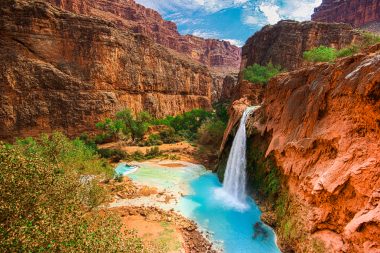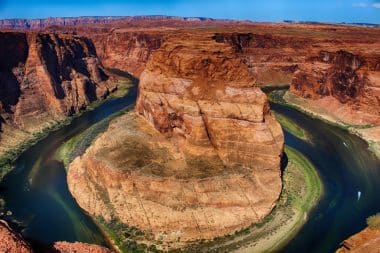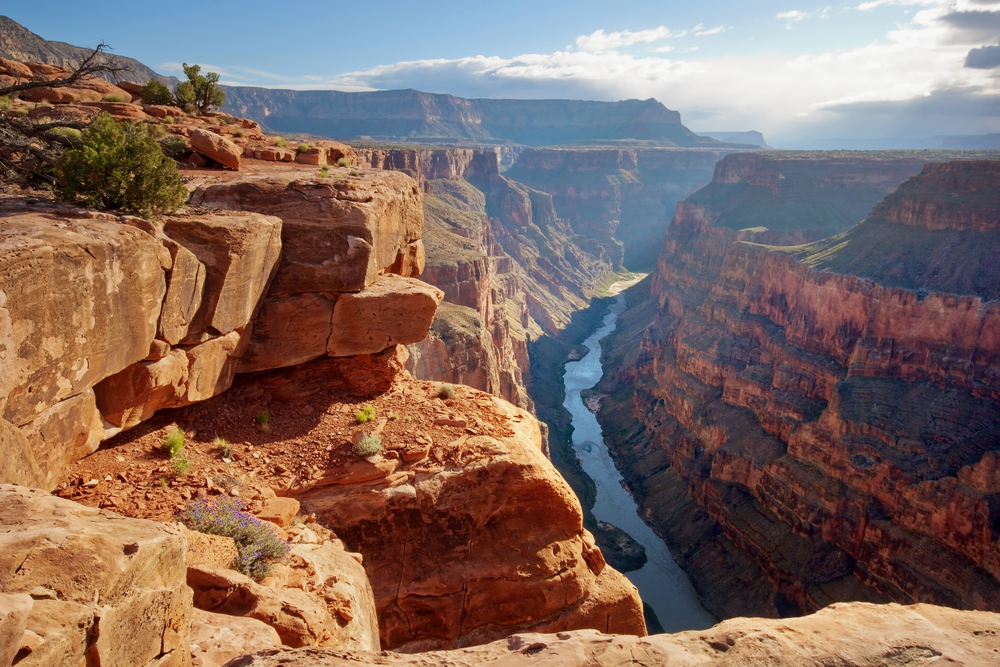Grand Canyon National Park is located in the state of Arizona in the USA and is the 15th national park in the country. Of course, the main attraction of the park is the Grand Canyon, a part of the Colorado River that ends in a canyon. It is often referred to as a wonder of the world. The national park has a total area of just under 5000 km². In 2017, it had a new visitor record of over 6 million people. That’s a very large number, to be exact, the second largest of all the parks in the USA. Only the Great Smoky Mountains National Park has had more guests. Since 1979, the park has been a UNESCO World Heritage Site.
Grand Canyon – The Creation

The Grand Canyon, with its numerous side canyons, is known for its combination of size, depth, and exposed layers of colorful rocks from the Precambrian period. The canyon itself was formed by cutting into the Colorado River and its tributaries after the Colorado Plateau was raised, causing the Colorado River system to develop on its current path.
The main public areas of the park are the south and north rims, as well as adjacent areas of the canyon. The rest of the park is extremely rugged and remote, although many places are accessible by dirt roads and country roads. The South Rim is more accessible than the North Rim and accounts for 90% of park visits. The park’s headquarters are located in Grand Canyon Village, not far from the park’s south entrance, near one of the most popular viewpoints.
The parts of the park in a nutshell

The South Rim has the most visitors to the entire park, as they reach it via Arizona State Route 64, a highway that runs from Tusayan, Arizona. This leaves the park again via an east exit. Interstate 40 leads into the park from the south. From the north, on the other hand, Route 89 leads from Utah to Colorado. If you want to visit the northern edge area, you have to drive over the Kaibab Plateau or the Walhalla Plateau. Anyone who enters here is at an altitude of 2,400 m above sea level. This is significantly higher than the southern edge. In winter, this area is usually closed due to snowfall. If you want to reach the southern edge via the northern edge, you have to drive 350 kilometers, which is about 4.5 hours driving time. If you find your way here, you should take a look at what is probably the most important visitor center in the entire park, Grand Canyon Village. There is a hospital on the premises, a gas station, food, souvenirs, as well as numerous accommodations. Access to hiking trails is marked. There is also a church.
Accommodation and more
Along the southern edge, several accommodations are available for guests. These are hotels and other houses, such as El Tovar, Bright Angel Lodge, Kachina Lodge, Thunderbird Lodge and Maswik Lodge, all located in the village area. If you want to experience more of the USA, you can stay at the Phantom Ranch, which is located on the canyon floor. There is also an RV park called Trailer Village. All of these facilities are managed by Xanterra Parks & Resorts, while Yavapai Lodge, which is also located in the village area, is managed by Delaware North.
On the North Rim, there is the historic Grand Canyon Lodge, which is managed by Forever Resorts. There is also a campsite near this accommodation. The park’s staff manages it and warmly welcomes its guests. Either you sleep in your own caravan, which you bring with you, or book a hut.
Facts about the Grand Canyon
- Size: The Grand Canyon is about 446 kilometers long, up to 29 kilometers wide and over 1.6 kilometers deep. It is therefore one of the largest canyons in the world.
- Geology: The geological structure of the Grand Canyon is particularly remarkable because it reveals layers from millions of years of Earth’s history. The oldest rock layers at the bottom of the canyon are over 1.8 billion years old.
- Formation: The Grand Canyon was formed over millions of years by the erosion of the Colorado River and its tributaries.
- National Park: The Grand Canyon is a US national park and was officially designated a national park in 1919. It attracts millions of visitors from all over the world every year.
- Wildlife: The park is home to more than 1,500 species of plants, over 450 species of animals, and about 175 species of birds.
- Colorado River: The Colorado River, which shaped the canyon, is a popular spot for whitewater rafting.
- Native American Heritage: The Grand Canyon has a deep meaning for many Native American cultures. The area has been inhabited for thousands of years and contains many archaeological sites.
- Tourism: Every year, millions of people visit the Grand Canyon. Popular activities include hiking, camping, rafting, and helicopter rides over the canyon.
- Skywalk: One of the most notable features of the Grand Canyon is the Grand Canyon Skywalk, a glass observation deck that rises 21 meters above the canyon’s rim, giving visitors stunning views of the canyon.


